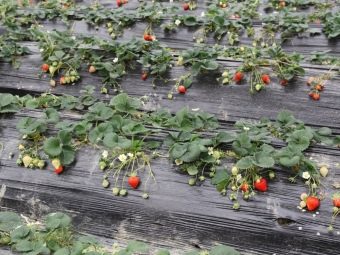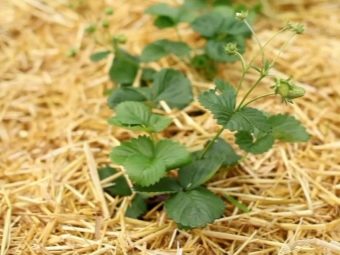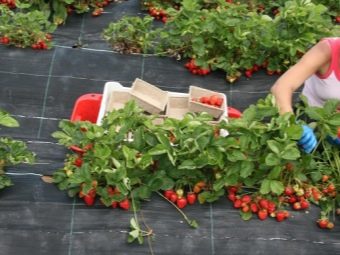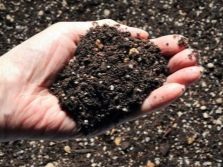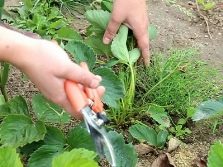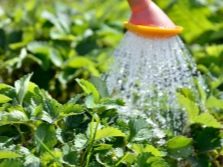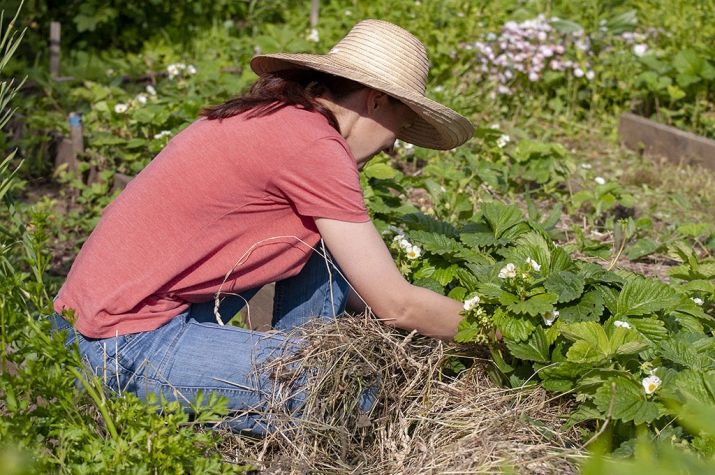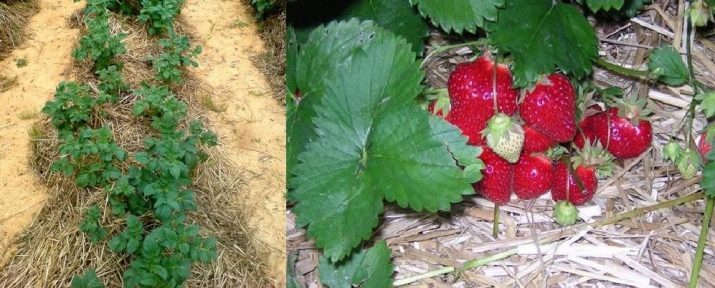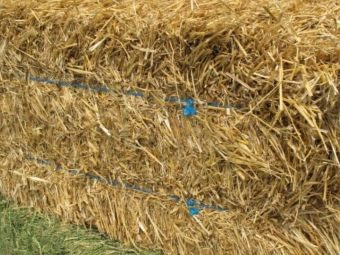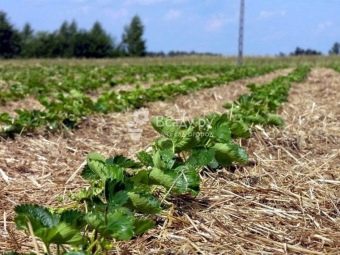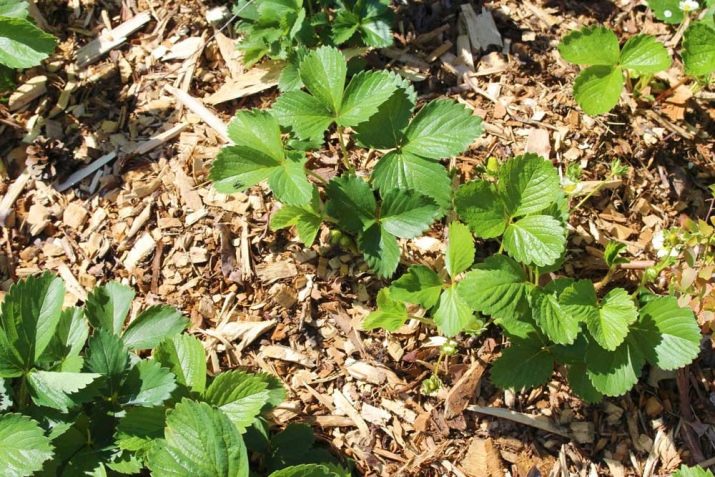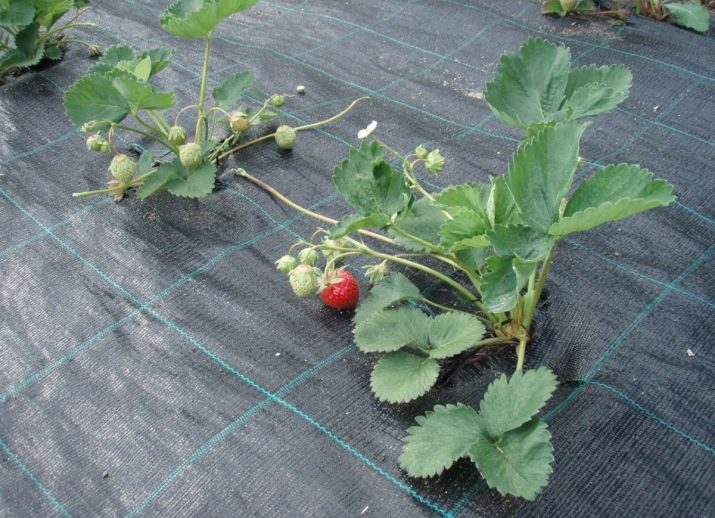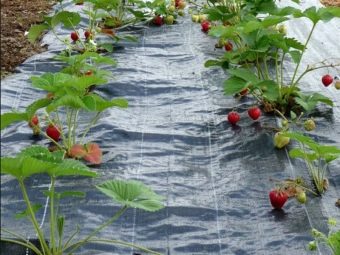Peculiarities of strawberry mulching
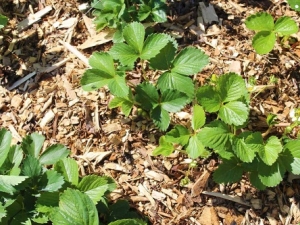
Growing garden crops at your summer cottage, you must comply with a whole range of agrotechnical measures, especially for plants such as strawberries. Among the mandatory work is to highlight the mulching of the ridges, since these measures allow to solve several priorities for the care of culture.
What it is?
Autumn and spring are important periods during which it is necessary to pay special attention to strawberries grown on the site. In particular, this applies to the treatment of soil on strawberry ridges, where mulching is quite effective. As the practice and experience of gardeners shows, covering the ground with various materials has an extremely positive effect on the plant, its development and fruiting.
However, in order for the work to be performed correctly, it is necessary to clearly know what the process is. Giving the definition of this task for the care of crops, it is worth noting that mulching involves covering the soil on the ridges or in the surrounding range of various organic or synthetic raw materials. The first type of materials used, as a rule, rottes over time, as a result, the culture gets an additional feed with useful substances.
The main purpose of mulching strawberries is to provide the plant with optimal moisture and temperature, because the berry belongs to moisture-loving crops, and is quite susceptible to fluctuations in air temperature.
In addition to the main function of sheltering the top layer of soil near the plants, several more targeted uses of mulching can be distinguished:
- most of the natural raw materials used are capable of fertilizing the soil with useful microelements;
- due to the layer of mulch, the nutrition of horticultural crops is significantly improved;
- shelter contributes to the normalization of air-gas exchange;
- mulch acts as a protection against various negative factors, for example, in summer from heat, and in winter from frost;
- if the ridges with strawberries are placed on a slope, mulching will help to avoid flushing the ground;
- In addition, such agrotechnics allows keeping the crop clean and the future harvest, which is important for strawberries;
- mulch creates a favorable environment for earthworms;
- thanks to the mulching of the beds, weed development can be avoided, which excludes weeding from the list of mandatory care measures.
Based on the above functional tasks, it can be said that the shelter of the soil near the strawberry bushes is an analogue of the natural mulching by the biocomplex. Under natural conditions, as a protective and nutritive layer, as a rule, fallen leaves, needles, in the open areas, mulching occurs with meadow grasses, thus avoiding soil erosion. It is this feature that triggered the widespread mulching of plants that are cultivated in personal or industrial gardens.
Proper use of raw materials can significantly reduce labor costs related to the care of the berry crop, as well as a positive effect on the fruiting and taste of berries.
Advantages and disadvantages
Any agrotechnical event has strengths and weaknesses, so to get the most effective result from mulching strawberry beds it is worth exploring these points.
The positive properties include the following:
- due to well-laid protective layer, the rate of irrigation is significantly reduced, since the mulch allows you to save moisture in the soil;
- the distribution of the injected fluid in the berry beds occurs evenly;
- due to the level of humidity created by the layer, air exchange is normalized in the ground in a natural way, as the earth is loosened by earthworms;
- taking care of mulch cultivation, it is possible to reduce the amount of fertilizer injected, due to the fact that the composition of the soil will be naturally balanced;
- a layer of material will provide the root system of the plant with reliable protection against temperature changes in the autumn and spring;
- during the fruiting period, mulch contributes to an increase in crop volumes by at least half;
- the raw material saves the crop from soil pollution during irrigation and natural precipitation.
Despite a lot of positive qualities of this agrotechnical device, it has some negative properties:
- under the layer lined with errors, can begin the process of rotting the root system;
- there are cases of the development of fungal diseases;
- In addition to beneficial insects, wet soil can become a refuge for pests, such as slugs or polar bear.
According to reviews, the risk of developing negative situations increases in the rainy season, so during this period measures should be taken to prevent the incidence and reproduction of insect pests.
Timing
It should be understood that the mulch should not cover the soil on strawberry beds all year round; with the arrival of spring, the soil should warm up well to give the plants an impetus for development. If we ignore these recommendations, the growing season of the crop will be extended over time. Therefore, it is better to mulch the bushes only after the start of the formation of the flower ovaries.
Creating a protective and nutrient layer can also be postponed for the summer months, but regardless of the period chosen for work, the land and culture should be prepared before mulching.
This process includes the following steps:
- loosening the beds;
- removing weeds, trimming mustaches and unhealthy leaves on bushes;
- soil moistening and fertilizer with complex preparations.
Autumn mulching of the soil falls at the end of September, at this time the culture goes into a resting phase. These works should provide good thermoregulation to protect the plant root system from freezing, as well as reduce the risk of damage during the thaw.
However, a layer of organic or synthetic material needs care and control over the state of the raw materials. The natural layer needs to be moved, turned over and replaced the worn material with a new one. The important point is the density of contact of the mulch with the stem. For good air exchange it is necessary to leave a small gap between them.
Choosing Mulch
In order not to be mistaken with the choice of raw materials for mulching strawberry beds, it is necessary to correctly determine the purpose of the layer, since different types of material can perform different tasks, for example, act as a protective barrier against ailments or form a particular environment in the soil. After examining the diversity and assessing the positive and negative qualities of materials, you can easily find the right tool for the job. The main materials used to form the mulch layer around the plants are presented below.
Straw
This natural raw material is a leader among the materials recommended for berry crops. It should be noted that only dry material is used for such works, freshly cut grass will not be suitable for mulching. The main advantage of straw is the presence in the composition of fiber, which decomposes for a rather long time, so that the cut grass is not subject to rapid rotting.
However, this feature has a negative side, because fiber can not be a full source of nutrients, in addition, it contributes to the depletion of the soil, pulling it out of nitrogen. To minimize these negative aspects, layers of mulch from cut grass are combined with rotted compost or manure.
For loose soil, the straw layer should be no more than 20 centimeters, with time the layer height will decrease several times.For clay soil, the optimal layer will be 5 centimeters, with the surface being renewed every two weeks.
Choosing this material to shelter the ridges, you should be prepared for the fact that it is a favorable environment for small rodents, so in the fall the straw must be removed and replaced with a more suitable option for wintering the plant.
Needles
A positive property of the needles is the presence of disinfectants in the composition, in the light of which the raw material acts as a reliable protective barrier against diseases and insect pests. In addition, if you use the needles correctly, you can improve the organoleptic qualities of the crop. However, it is worth knowing that tanning components can increase the acidity of the soil, due to which slaked lime is introduced into the soil before laying coniferous mulch.
In addition to its strengths, such a natural material has disadvantages. First of all, it concerns the impossibility to reliably protect the soil from high temperatures in the heat, because the needles form a loose layer through which heated air penetrates. Needles also let through the shoots of weeds.
In order for such a layer to hinder the development of weeds, it must be laid out in a dense thirty-centimeter layer, which in practice will be problematic. Typically, the coniferous coating reaches three centimeters, using slightly dried needles for work.
In the spring months, coniferous mulch needs to be updated, it is not necessary to dispose of old material, it will be enough to dig it along with the ground.
Tree bark
The best option for strawberry would be pine or larch. Of all the available natural materials, the bark is the most durable option, which is perfect for protecting crops in the winter, in addition, reliably saves the bushes from overheating. The bark retains moisture well and gives the ridge a more attractive look, especially with lawn grass. The service life of bark mulch is about 5 years.
Sawdust
The raw material decomposes for quite a long time, due to which it cannot provide nutrients to the culture, but at the same time it has a long service life. Thanks to its rough texture, sawdust will become an obstacle to the habitat of slugs and snails in this part of the garden.
But when choosing this type of material it is worth considering that the sawdust very well absorb liquid, so the material will be able to give moisture to plants only after it is fed to the maximum. Such a feature of the material will require an increase in the volume of irrigation of culture. This version of mulch has a universal purpose, so it is used at any time of the year.
Cardboard
Frequent use cases for mulching strawberry cardboard. Work with such material should be done in the spring. Shrubs can be covered with cardboard overlap, leaving a small gap near the stem itself, through which watering and fertilizer introduction are performed.
Spunbond
This raw material belongs to geosynthetic products, it does not let the rays of light through and perfectly retains moisture and temperature. Work with the material is performed by making perforations in the fiber and laying on the ground. Plants rooted in the holes formed. On ridges with already growing cultures material line the aisles.
Film
The strawberry film is selected medium in thickness, black. For areas with hot climates, a light colored material is produced, but with a dark inner layer. Such mulching helps keep moisture inside, preventing overheating of crops.
Often there are cases of using the whole composition of materials for soil mulching. Dry substances or fabrics act as components, in addition, ridges are often covered with moss.
Useful tips
To maintain the effect of mulching the ridges, it is worth treating all the free ground space from the bushes, leaving no aisle without shelter.
To avoid contamination of crops, last year’s materials should be removed in the spring, allowing the ground to warm up.
In addition, during the winter, quite a lot of dead parts can be formed in the natural layer of mulch, which must be removed to prevent the development of fungal infections.
Young bushes require a special attention, which the layer of mulch will help to overwinter and not lose the ability to fruiting.
On how to mulch strawberries, see below.

